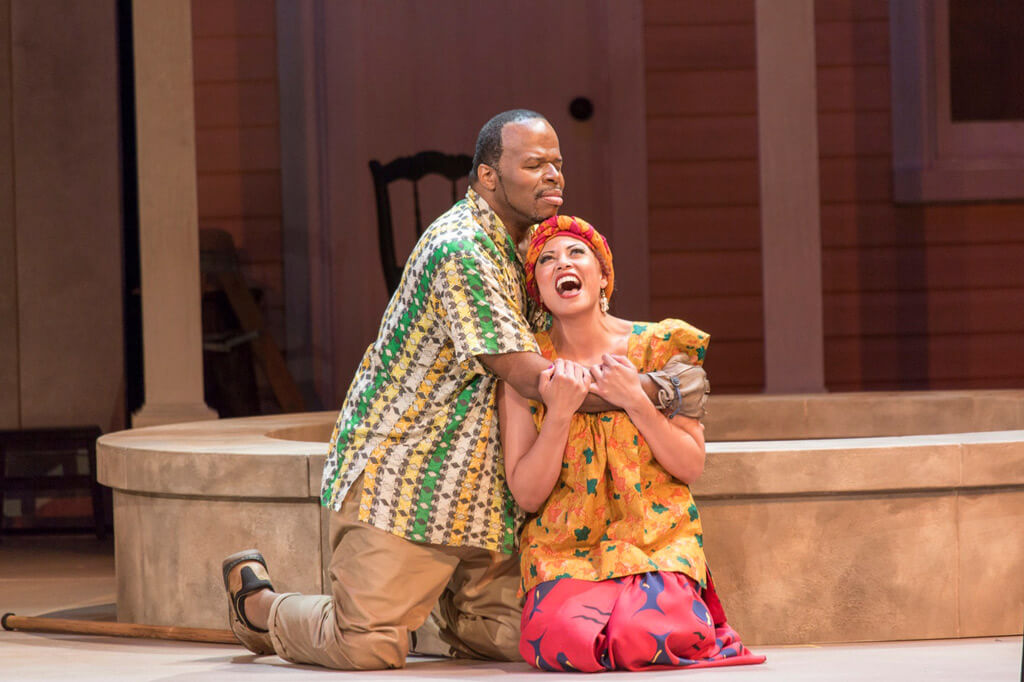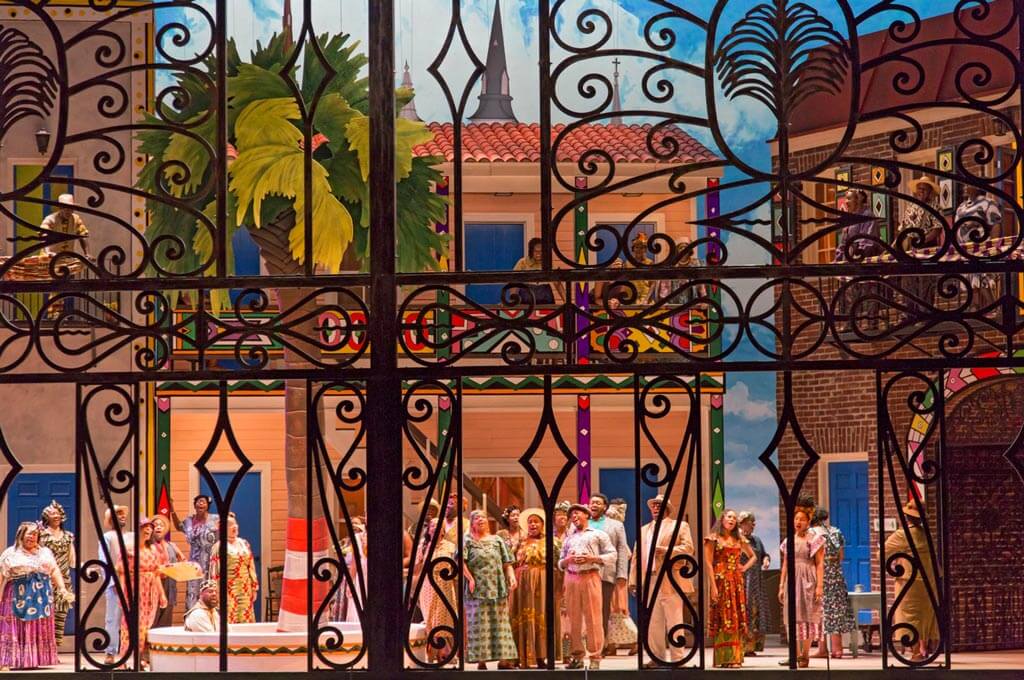
Pt. 1 of 2 Reports from the Spoleto Festival
CHARLESTON, SC — Charleston, South Carolina is one of the premier travel destinations in the world, and its hotels and restaurants are packed year-round, but for the annual Spoleto Festival, everything is kicked up a notch. This year, the 40th–anniversary of this continually challenging and surprising celebration of the arts, both the performances and the venues aimed to top everything that had come before. Undoubtedly, the highlight had to be the festival’s first-ever production of Gershwin’s Porgy & Bess. The opera is set in Charleston, and this production seemed authentic in every detail. But there were other operas, plays and dance performances, and chamber music as only Spoleto can do it, with violinist Geoff Nuttall of the St.Lawrence String Quartet at the helm. More about these events in Pt. 2 of my report from Charleston.
Spoleto Festival USA is actually an offshoot of the Festival dei Due Mondi (Festival of Two Worlds) created by composer Gian Carlo Menotti in Spoleto, Italy in 1958. The U.S. counterpart was founded in 1977. Menotti picked Charleston because of its “Old World charm” and because it had some suitable theatres within walking distance of each other.
By the early 1990s, Spoleto Festival USA had sent down deep roots, but chronic financial problems led to a split between Menotti and general manager, Nigel Redden. Redden was forced out, Menotti soldiered on, but the financial difficulties continued to mount. In 1993, Menotti packed it in, and Redden was called back to right the ship. He did so and has been in charge of the festival ever since.
The opera Porgy & Bess was based on the novel Porgy (1925) by Charleston native DuBose Heyward (1885-1940). The novel was later turned into a play, which George and Ira Gershwin saw on Broadway in 1927. They were excited by the story, and the Metropolitan Opera commissioned them to write an opera based on it. When the Met demanded that white singers in blackface take the leading roles, the Gershwins refused and presented the opera on Broadway with an all-black cast in 1935.
Gershwin actually visited Charleston at the invitation of DuBose Heyward and immersed himself in the sights and sounds of the area. He not only went to local churches to hear black spirituals but also went to hear the “shouting” of the local Gullah. According to Heyward, George got so caught up in the shouting that he started shouting with them. In Heyward’s words, “I think that he is probably the only white man in America who could have done it.”

For this 2016 Spoleto production, Nigel Redden recruited the most celebrated artist in Charleston to come up with a concept. Jonathan Green was born and reared in the Gullah community of South Carolina, and he accepted the invitation, provided he could stage Porgy in his own way. He didn’t want the characters of the opera presented as poor and bedraggled; rather, they should be seen as exemplifying their African roots, mixed in with American culture. As the opera unfolds, we see sets and costumes gradually transformed into a brilliant panoply of colours — reds, yellows, whites and blues — as the proud Gullah people find their voices and their self-confidence. At the end of the opera, when Porgy declares “Lord, I’m on my way!” he is expressing not only his own feelings but the pride and positivity of the entire Gullah community. Jonathan Green’s vision for Porgy fits the opera like a glove and, at the same time, affirms the hopefulness of black people in America today.
The performers were entirely worthy of Green’s concept. Lester Lynch as Porgy just got better and better, and Eric Greene as Crown not only sang magnificently but was ridiculously handsome and menacing at the same time. Alyson Cambridge as Bess had a strong dramatic presence, but her voice was too often harsh under pressure. The Johnson C. Smith University Concert Choir from Charlotte, North Carolina was simply stunning in its richness and power, and individual members of the choir proved to be natural character actors too.
The jazz piano solo, which opens the opera after the overture, is omitted in many productions, but here it was not. Pianist Tuffus Zimbabwe — Jasbo Brown in the opera — performs on “Saturday Night Live”, and is the grandson of Mildred Jenkins, a professional singer and sister of the African-American composer Edmund Thornton Jenkins (1894-1926), whose operetta Afram ou la Belle Swita was also performed this season at Spoleto Festival USA.
The singers, visual designer Jonathan Green and director David Herskovits all deserve high praise for what they accomplished, and the Spoleto Festival USA Orchestra, under the energetic and authoritative direction of conductor Stefan Asbury, provided exemplary support from the pit. The orchestra is comprised of young professionals just starting their careers but the talent assembled here was just astonishing.
There is no doubt that this production of Porgy & Bess benefitted from the acoustics of the newly refurbished Charleston Gaillard Center. The building is beautiful to behold inside and out and gives the performers everything they could wish for regarding quality of sound and excellence of stage facilities. One mundane failing must be noted — and it seems to be a universal blind spot for architects — the toilet facilities for the audience are totally inadequate in terms of both quantity and access.
It should also be noted that, once again, producers have failed to notice that words sung in almost any language, including English, without benefit of a microphone, are almost always incomprehensible. The technology to overcome this problem and make opera-going a more pleasurable experience than ever before has been around for years; why, then, were there no surtitles for Porgy & Bess?
As an added feature, the festival went to great lengths to contextualise their production of Porgy. A walking tour of Charleston introduced music-lovers to many of the homes and other buildings related to the Porgy & Bess story. There was also an exhibition under the title “I Got Plenty O’Nuttin”: Gershwin’s Charleston, held at the Charleston Museum and another called “Beyond Catfish Row: The Art of Porgy and Bess” featuring the work of Jonathan Green, George Biddle and Kara Walker at the Gibbes Museum of Art.
For Pt. 2, featuring Lachenmann’s “The Little Match Girl”, Dauvergne’s opera La Coquette trompée, and the St. Lawrence String Quartet, read here.
#LUDWIGVAN
Want more updates on Toronto-centric classical music news and review before anyone else finds out? Get our exclusive newsletter here and follow us on Facebook for all the latest.
- SCRUTINY | TSO Lets Berlioz Do The Talking In Season Opener - September 21, 2018
- RECORD KEEPING | Even Yannick Nézet-Séguin Can’t Make Us Love Mozart’s La Clemenza di Tito - September 6, 2018
- RECORD KEEPING | Giovanna d’Arco With Anna Netrebko Explains Why The Best Operas Survive - August 30, 2018



